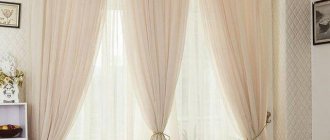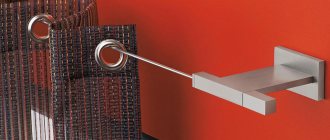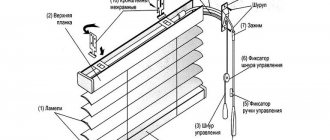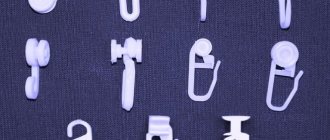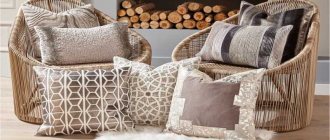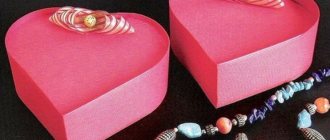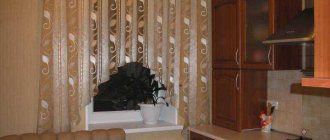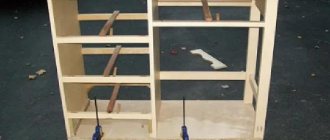Making curtain tiebacks with your own hands is easy and profitable. Often they suit the interior of the room better than finished products. Based on the proposed ideas for inspiration, you can come up with your own, unique version.
The main purpose of curtain tiebacks
Tiebacks combine aesthetics and functionality:
- fix the curtains at the desired level;
- decorate the curtains;
- bring a touch of style, novelty or originality to the interior;
- They focus attention on the texture of the curtain fabric (this effect is achieved by collecting the fabric into shaped folds);
- make the room brighter;
- hide curtain defects or model flaws;
- visually expand or lengthen the space (depending on the height of the hairpin).
Types of grabs
There are these types of pickups:
- hard;
- fabric;
- wicker;
- designer (made to order or independently).
Kanzashi
They are a hairpin of any shape, trimmed with silk or satin ribbons and flowers. They are made using the Japanese technique Hana kanzashi. Square pieces of tape 2.5-3 cm wide are folded diagonally, and then in half using tongs they are shaped into petals, which are glued to the base.
Hard
Static holders are made of metal, plastic or wood. In shape they resemble a hook, a knob handle (the curtain is thrown over such a tie without creasing) or a hairpin, which consists of a base and a pin.
The base can have the shape of one or several rings, an oval, a square, a heart, a triangle, etc. It is decorated with ornaments and patterns.
Magnetic
The models consist of 3 parts: a decorative element, a base (magnets) and a jumper. The curtain is captured by a jumper and the magnetized elements are connected to each other through a layer of fabric. The decorative detail, decorated with rhinestones or enamel, remains in the foreground.
Cords with tassels
This type of tie is considered classic; it matches noble and heavy curtains. Depending on the production technique, twisted, braided and knitted cords are distinguished. Brushes are located at both ends. They must match the color of the cord. Sometimes the product is tinted with gold or silver paint.
Fabric
The holders are sewn from the same fabric as the curtains, or in a contrasting color. The standard “banana” model has a shape that is tapered at the ends. It is sewn on both sides, with or without internal lining. In the hardest models that hold their shape well, there are plastic inserts between the layers of fabric.
Decoration includes embroidery, fringe, ribbons, beads, ruffles, beads, etc.
Homemade
Homemade tiebacks include any devices and products that can fix and hold an assembled curtain, for example:
- round door handles in vintage style with beautiful forging;
- leather belts;
- suspender;
- threads woven in the form of braids or using the macrame technique;
- ties;
- carbines;
- wooden spools of thread strung on a rope;
- patches, scarves.
How and with what to tie curtains correctly - types of garters
Bandages are made from various materials - fabric, metal, wood, plastic, they have different shapes and sizes. Conventionally, these products are divided into several groups.
Hard
They are made from stainless steel, copper and copper alloys (brass, bronze), more expensive metals (for example, blackened silver), wood, and plastic. Rigid clamps are permanently attached to the wall using dowels and self-tapping screws. Moving them to a new place is quite difficult. Shape – a hook with decorative elements, a door handle or a special product stylized as a door handle. The product can be completely invisible against the background of the curtain or decorate it, thanks to the use of stones and forged elements in the decor.
Flexible
Such garters are made from non-staining practical fabrics or plastic polymers. To hold heavy curtains, products made of natural or artificial leather are used. The most popular form is “banana”.
Fabric tiebacks usually have a lining of the same color as the front part, a companion color, contrasting. For reinforcement, a wire frame, plastic or cardboard element is placed between the layers of fabric. Lace, beads, and hairpins are used for decoration. You can sew the products yourself or order them from a studio, where they will help you choose the appropriate option and carry out the work at a professional level.
Flexible garters are attached to the curtain itself. They either tighten the fabric or move it towards an additional holder mounted on the wall. For such fastening, it is better to purchase a decorative hook from a hardware store; as a last resort, get by with an ordinary nail. Light curtains can be fixed using a small hook, which is attached to a smooth wall with double-sided tape.
An interesting option is tackling using the kanzashi technique. They are not sold ready-made, but are made individually. Such garters are flowers and leaves made of satin ribbons, in addition to which are used: organza, lurex fabric, lace, and beads. The products look great in romantic or oriental style interiors.
Another way to decorate flexible tiebacks is to use foamiran, a foam material that can change shape when heated and retain it after cooling. Very realistic flowers are made from it. Foamiran can be embossed, is easy to paint, does not fade and is not destroyed when exposed to sunlight.
Non-standard
Such grabs can have a variety of shapes - animal, bird, flower. They are made from wood, metal, improvised materials - ropes, solid or woven straps, lace strips, elements woven using the macrame technique. Cords for tiebacks are tinted with gold, silver or other paint, either solidly or with an ombre effect (a smooth transition from a dark shade to a light one). Suspenders are suitable for informal rooms.
An interesting option for a nursery, kitchen, or living room is decorating garters with plush animals and textile dolls. In eco-styles, decor made from pine cones and reeds looks great.
Hairpins
Curtain clips are rigid round-shaped clips with two holes into which a fixing stick is inserted. They tighten the fabric, but do not fix it to the wall or window unit. Suitable only for light voile or thread curtains.
Magnetic
This is a convenient option for draping light fabrics. This type of pickup is a tape with two magnets, the front part of which is usually small metal elements of regular geometric shape. To beautifully tie curtains with belts with magnets, you can choose sets decorated with stones and other decorative elements.
From beads
For heavy, plain curtains, large beads are used, collected on a strong thread or fishing line. Light transparent and translucent curtains can be assembled into several rows of small beads. The interweaving of beads and chains looks impressive and elegant; beautiful buttons, medallions and other jewelry are suitable as additional decoration.
Garters with tassels
A spectacular option to decorate curtains in the living room or bedroom is to tie them with cords and tassels. To complement the tiebacks, voluminous tassels are usually used to match the curtains (for bedrooms) or in contrasting colors (for elegant living rooms).
Did you like the curtains? You can order the same in the Living Room section
Types of materials
To make grabbers use:
- textile;
- ribbons;
- cords, ropes, decorative twine;
- burlap;
- fur;
- knitted fabric;
- skin;
- plastic;
- metal;
- magnets;
- elastic materials, etc.
Foamiran
Foamiran is a decorative foam material (its other names are foam rubber, foam EVA, plastic suede, revelour). Looks like thick paper, soft, elastic. Used to decorate flexible holders. Leaves and flowers are made from it - orchids, roses, bouquets of crocuses, tulips, etc., which look life-like. Foamiran is not afraid of moisture and sun.
Tree
Wooden holders complement the classic interior with simple-style curtains. More often, wood is used for gripping in the form of a pin (pin) or a handle attached to the wall. The surface of the wooden model can be smooth or carved.
Plastic
Plastic tiebacks imitate the texture of wood, stone, and metal. They come in different models. Plastic is used to make rigid holders and parts for other models. Jewelry is made from it (small figurines, beads, etc.). Plastic holders will not be able to support the weight of heavy curtains.
Cords
Suitable for interiors in styles: country, Scandinavian, minimalism. For weaving cords, cotton, linen, acrylic, viscose, polyester, metallized and hemp threads of 1 or 2 colors are used. Natural fibers are soft and pleasant to the touch, but require careful handling.
Synthetic ones are elastic and do not stretch during use. The minimum diameter of the cord for grabs is 5 mm.
Leather and leatherette
Leather tiebacks are used in medieval and loft style interiors. The products are durable - even a narrow strip of natural material will hold the curtain. The belt is in harmony with curtains of similar shades, with forged elements - a cornice or a hook on the wall. The product can be decorated with inlay or metal parts. Tiebacks made from a piece of suede or woven from 4-6 narrow strips of leather look more delicate.
Metal
Metal tiebacks of various designs will decorate industrial, loft, hi-tech, and empire interiors. Varieties of products: matte, shiny, simple and sophisticated, in the shape of a hand or a lion's paw, decorated with forging (leaves, curls, flowers), balls, stones, glass, embossing, etc. Metal tiebacks are the strongest and most expensive.
Types of tiebacks, clips and hairpins
Clamps are distinguished by their functions, material, and shape. Different curtains have their own curtain fasteners. You can often see tiebacks made from laces with tassels or other decorations at the end. Instead of a cord, chains of beads and ribbon are used. Smooth long curtains are decorated with neat ribbons without patterns, matching the shade with the fabric. Curtains with patterns require tiebacks similar to the curtain material.
Hairpins made of fabric, which on one side are the same color as the curtains, and on the other a shade that matches them or is harmonious but contrasting, look impressive. Tight tiebacks beautifully complement the lace fastenings, with loops and other decorative light details.
Clips in the form of large hairpins are additionally decorated with beads, seed beads, wicker elements, and flowers. Sometimes they choose tiebacks in the form of rings, which are attached to different sides of the window. These fasteners position the curtains beautifully, framing the window. There is also an option in the form of tape, which is used to cover the fabric and secure it to hooks in the wall.
Advice! Dense material or oilcloth is sewn to the inside of the scaffold so that it holds its shape well.
Curtains decorate the room, but you can also fold them beautifully and smooth out the folds on them. The clamps will do this. Such devices are made from fabrics, ribbons, and plastic.
Benefits of using curtain clips:
- By securing the curtains with tiebacks, they allow sunlight into the room and create beautiful, even folds.
- Clips automate the process of closing and opening curtains, eliminating multiple steps.
- The fabric is secured with tiebacks so that the room is well lit, or vice versa, so that the room remains twilight.
- To create new interior details and points to attract attention to the decor. Tiebacks are made from various materials and in any shape, so they find their own accessories for a specific style.
Accessories for grab bars
Functional accessories for fabric tiebacks include fastening blocks in the form of eyelets and loops made of metal or flap. Decorative items include embroidery, tassels, fringe, braid, beads, beads and other jewelry, children's toys, etc.
Bijouterie
They use 2-3 low beads that are out of fashion, or other jewelry, for example, chokers, matinet, chains with large links. Additional decorations - rhinestones, sparkles, decorative coins, single- or double-sided metal pendants in gold, antique silver or bronze (for example, “antique” keys, medallions, pendants, starfish, leaves, flowers, figurines of animals, birds, etc.).
Bows
The bow is sewn from the same fabric as the scoop, but jacquard fabric that is too heavy is not suitable for it. The accessory can be located either in the center of the assembled curtain, or near the window or closer to the wall. Options for bows: with short or hanging long ends, as well as without them, lush, strict, delicate, voluminous, two-color, multi-tiered.
Most often, decor is used in a girl’s room, in the bedroom or in the kitchen.
Beads
Beads made from jewelry alloys, bone, ceramic, glass and wood with wide holes are suitable for decoration. They are strung on a fishing line in 1-3 rows, alternating elements of different sizes, then encircled the curtain. Another option is beads sewn randomly.
Flowers
Flowers are made from ribbons and fabric (silk, organza, satin), leather, figured braid, felt, foamiran, beads, using the following techniques:
- sewing;
- Japanese - kanzashi (its principle is described above) and komono - flowers are created using a needle and thread on a cardboard circle;
- guilloche - burning using a special soldering iron;
- ganutel - using a wire frame;
- corrugation.
The holder can be decorated with one flower or a bouquet that completely hides the base.
A rose made of light light fabric or foamiran looks beautiful in combination with a pearl bead holder.
Ring
A ring (or kugel), depending on the diameter, allows you to drape a curtain made of threads and fabric of different densities. The decor is similar to a bracelet, ring or ring with rhinestones. The curtain is threaded through the hole. Cugels are made from metal, impregnated wood or plastic. Models come in plain, colored, variegated, transparent, metal colors, incl. aged.
Disk
Decorative disc-clips are made of wood, metal wire, decorated with plastic beads, rhinestones, etc. The outer diameter of the clip is from 9 to 20 cm. Discs are most often used for muslin. The curtain is pulled into the hole and fixed at the desired level with a pin, inserting it from the back.
Curtain tiebacks made of satin ribbons.
Rep ribbons, silk, satin, oganza. There are so many colors and shades on sale, you can create a composition of colored stripes for any style. Do you like classic style without frills?
A monochrome bow, similar in shade to the curtain fabric, can be quickly made in a matter of minutes.
You can sew a strip of fabric of a suitable color and decorate it with a bow.
A cute composition of pastel roses, mesh and beads, suitable for Provence style curtains.
Buttons in cheerful colors, felt and bows made from grosgrain ribbons. And the unusual decoration is ready.
Curtain tiebacks for children's rooms.
Toys, dolls, fairies, dolls and bears were cheerfully placed on the decoration for the window in the baby’s room. It would be original to design the pick-up in the shape of a capital letter of a name or hearts.
Butterflies and toys are sewn according to a pattern and filled with silicone. Decorated with beads and ribbons.
You don’t have to sew a special tie, but try on existing soft, neat toys and pompoms.
Pickup schemes
Diagrams of fabric tie-backs allow you to better examine the details of the model and choose a style.
To pattern 1 fastener of a strict shape, a flap 80 cm long and 20 cm wide (with seam allowances) is required. Cut out 1 piece, then bend it in half along the longitudinal line. A product with ruffles and folds requires more material.
The diagram shows rings and loops at the ends of the tiebacks, with the help of which it is attached to the wall.
Beautiful DIY curtain ties with a bow
You can make beautiful curtain ties with your own hands with a luxurious bow that will look very impressive on the window.
Instructions on how to sew tiebacks with a bow for curtains:
- Make a standard pick-up by adding 91.5-115 cm to the base length. And the cut width should be 25.5 cm. Do not tie.
- To keep the bow in front, use a 2.5 x 7.5 cm clip to prevent it from sliding forward. Plus, it will give the curtain a nice, neat edge appearance on the outside of the window.
- Determine the center of the pick-up by folding it in half crosswise and smoothing it lightly with your fingernail. Secure the location of the fold by marking it on the tieback and securing it with a button on the side closest to the window.
- Press the clip into the crease and attach the clip to the window opening or wall using two snaps.
- Wrap the tie back around the curtain and tie a bow.
To secure the bow to the outer edge:
- Find the transverse center of the pick-up.
- Measure from the center a distance equal to half the base length of the pick-up; make a mark on the top edge. Sew a ring at this point.
- Place the ring on the pick-up holder. Wrap the tieback around the curtain. Tie a bow on the outer edge.
Original ideas and manufacturing instructions
To make sure that the tack fabric fits the curtain, you need to wrap or pin a sample of the selected material around it and leave it for a while, observing the combination of textures and colors in daylight and artificial light.
Disc holder
For 1 grab you will need: 1 CD, corrugated cardboard, scissors and glue.
Work order:
- Mark the boundaries of the inner diameter of the holder on the disks using a compass.
- Cut. Treat edges to remove burrs.
- Cut out the same piece from cardboard. Glue it to the plastic one.
- Wrap the hairpin with a material that matches the fabric of the curtains: ribbons, yarn, jute twine, trying to pull it evenly.
- Decorate with elements of the same or similar material (curls, flowers). As a hairpin, use a knitting needle, painted in the color of the hairpin.
Knitted
Openwork tiebacks are knitted in the form of stripes. You will need a pattern, threads and a hook. In the central longitudinal row, a row of double crochets is knitted and a ribbon is threaded through the holes formed. It will not allow the product to deform and will serve as decoration.
On magnets
For 1 curtain you will need: 2 magnets (if the curtain is heavy - 4), a flap or ribbon to connect them, decorative elements (keychains, buttons, shells, flowers and leaves made of textile or dry, such as a bouquet of Kermek, etc.), hot glue.
Performance:
- Sew a jumper about 30 cm long.
- Leave the ends open. Glue magnets to them and wrap the edges.
- Decorate, focusing on magnets.
From a plastic bucket
The principle of operation of the holder is the same as that of a product made from a disk, but due to the bends of the walls of the bucket, it covers the curtain from the front and sides. This allows you to secure it with a pin without crushing it.
To make it you need: a plastic paint bucket with a capacity of 5 liters, scissors, a marker, double-sided tape, sushi sticks, acrylic paint for them, hot melt glue, yarn or other threads for finishing.
Step-by-step instruction:
- On the side surface of the bucket, mark the contours of the pickup in the form of an oval with a marker. To keep the part even, it is better to use a template. Cut out.
- Cover the edges with tape.
- Wrap with yarn. The coils should fit tightly to each other. Glue the ends of the threads to the inside of the product.
- Wrap with contrasting threads with distances of 0.5-1 cm between turns.
- Paint the sticks. Try on the holder. Glue flat elements of ornamental jewelry onto the visible part of the ends of the sticks.
With ruffles
Take: an elastic band 3-4 cm wide (a narrower one will not give a beautiful fit), a strip of fabric 1.5-3 times longer than the elastic band, beads or other decorative elements.
The pickup is done like this:
- Process the bottom edge.
- Attach the elastic to the top edge, turning it to the wrong side. The elastic is stretched so that a frill of the desired pomp is formed.
- From the inside, the grip is reinforced with tape or braid.
- Decorate the top edge with several rows of beads if the fabric is transparent. Otherwise, individual small elements will do.
Choice of style and design
The variety of clamp design options offered on the market is great and allows you to choose a product that fully matches the interior of the room and the chosen style. Ideas for curtain clips are not limited to standard products; with a creative approach, it is quite possible to create a curtain clip with your own hands, taking into account the smallest nuances of room design.
Accessories can complement the decor of curtains, set it off, or play the role of independent decorative elements. The following combinations look original and harmonious:
- Bright curtains with a variegated pattern look good with plain clips, while at the same time, you can refresh a plain, dull fabric with accessories made of polished metal or sparkling stones.
- Brooches, hairpins and magnets imitating precious stones will complement the luxurious Baroque style.
- The nursery will be decorated with clips of soft toys hugging the curtain. A bear cub or a monkey with its paws wrapped around the fabric looks original.
- The kanzashi clip will organically fit into the oriental interior.
- Cylindrical holders in the shape of cups or earthenware jugs would be appropriate in a kitchen decorated in a country style. You can also use clips in the shape of butterflies, dragonflies or bouquets.
- Transparent plastic and glass, matte or polished metal will suit the high-tech style.
Don’t be afraid to experiment with different types of clips; when choosing, they focus not only on the design of the curtains, but also link them to other furnishings - lamps, wall decorations or furniture fittings.
Fixing grabs
Options for attaching tiebacks for long curtains:
- at the level of the window sill or at a height of 100 cm from the floor - a standard option that allows the use of brushes;
- higher, at a height of 2/3 from the floor level (opens the window opening to the maximum, suitable for curtains with a lambrequin);
- below the window sill, 1/3 of the curtains from the floor level.
The eyelets at the ends of the fabric tiebacks cling to the hooks. Rigid holders, handles and hooks are attached to the wall at a distance of 10-15 cm from the edge of the window opening.
You don't need a hook on the wall to attach magnetic holders and hairpins.
How to make curtain clips with your own hands
Despite the chic selection of fasteners, you can independently implement the most non-standard ideas for curtain design, taking into account the subtleties of style and your own taste. It is not difficult to make such products; you just need to show a little imagination and perseverance, then unusual and unique decorations will decorate the room.
They can easily hold even the heaviest drapery and fit perfectly into Provence, rustic, and modern interiors.
We offer several ways to make original curtain clips with your own hands.
- Oriental-style hairpins, called kanzashi, are suitable for decorating curtains in the living room. They are made using old CDs, sushi sticks and satin ribbons. To do this, widen the hole in the disk, then wrap the edges with tape. The hairpin can be decorated with fabric flowers, beads or rhinestones.
Tiebacks using the “Hana kanzashi” technique are unique hairpins decorated with silk flowers created by folding squares of different sizes.
- Toy holders are popular for children's rooms. Cute cats or bears are attached to the assembled curtain with buttons or ribbons, resulting in the impression that the animal is wrapping its paws around the curtain.
Knitted products - made using a hook, knitting needles, bobbins, decorated with buttons, beads, pom-poms.
- For curtains in the kitchen, veranda or dining room, you can use cups, small jugs or other utensils. The bottom of the dish is removed, after which the fabric is threaded through the hole formed. Fix the product with a hook on the wall. An even simpler way is to bend a fork or spoon, and the unusual clamp is ready.
Cup tiebacks: unexpected and practical. It is important that the cup is not cracked - it will not hold heavy fabric.
Important! The finished product should not have defects, roughness or sharp edges that could cause injury during use or damage the fabric.

